The most common question that arises before starting an embroidery project is what is the best fabric for hand embroidery? It is very simple to answer. We don’t always use the same type of fabric for every embroidery project. The fabric used for embroidery is available in cotton, linen, blends, etc. It is possible to embroider on any fabric but some are good than others.
So, what is the best fabric for hand embroidery? Before choosing fabric for embroidery always think that what your finished project will be. Whether it will be table cloth or decorative dress. Depending upon the final project and which floss you will use them accordingly the fabric is selected. There is soo much variety of fabric to choose from. I have shared a few tips on the selection of fabrics and also tips on sticking on them.
Since there are a variety of fabrics depending upon different thread counts, weight, cotton, linen, color, etc. means there is no one embroidery fabric to be used every time. The selection of fabric depends upon the final project. There are some tips like if you want to do fine and detailed embroidery select finer fabric and for cross stitch or counted stitch, evenweave linens are good. Let us see in detail about the fabric which can help you to select base fabric for your embroidery projects.
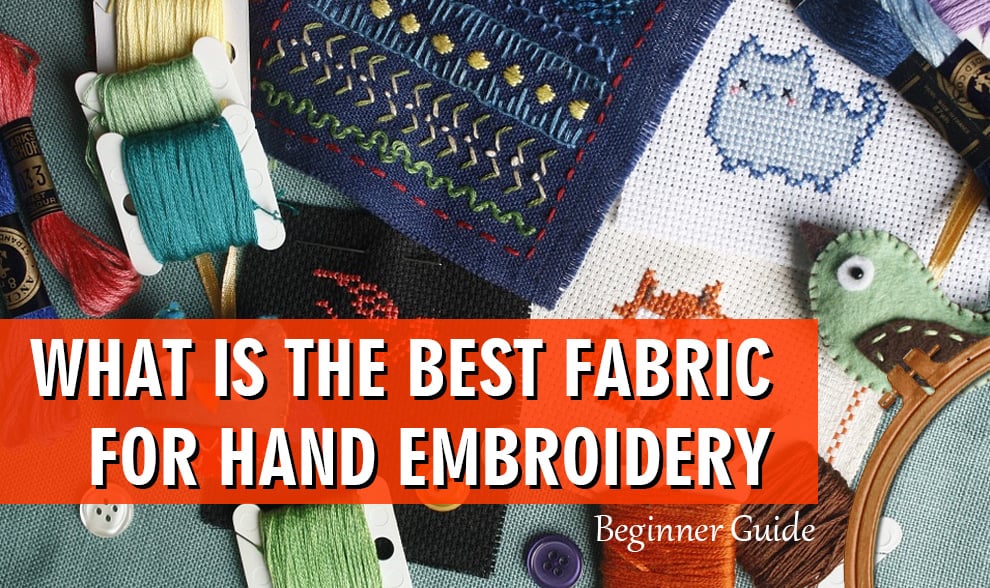
Table of Contents
Find the Purpose of your embroidery project:
Yes, Very first thing is to find out the purpose of your embroidery project. Do you want to embroider a pillow cover, table-cover, a beautiful dress, or embellishing function outfit?
This will help you to find base fabric for your embroidery project.
What type of stitch are you selecting for the project?
You need to keep in mind that the project will be heavily stitched or not. Lots of dense filling embroidery required heavy fabric that can support the stitches. Hence the type of embroidery oy stitches you are planning to do will influence the type of fabric you need to choose for your project.
If you are a beginner in embroidery then do checkout 10 Basic Hand Embroidery Stitches For Beginners.
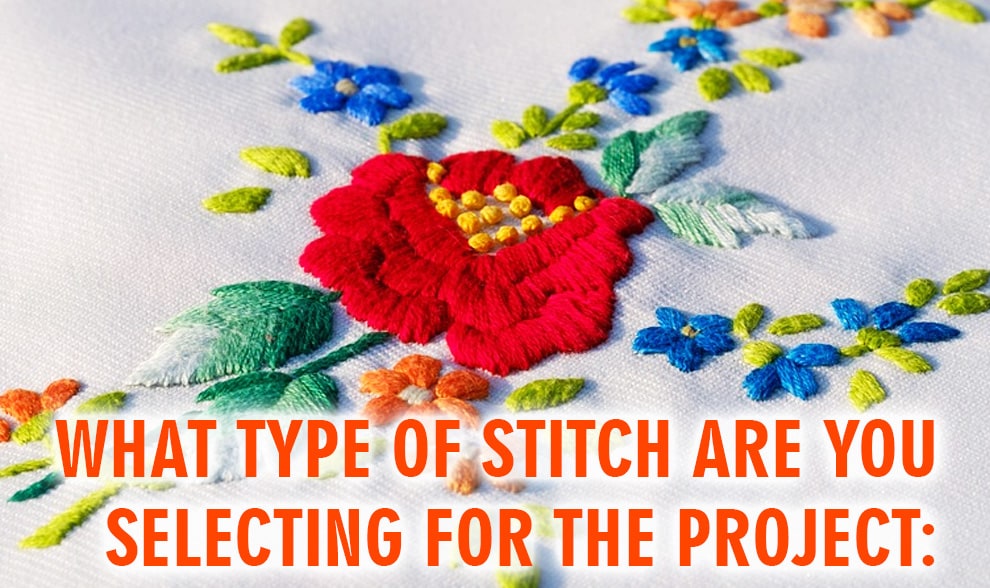
If you are thinking about surface embroidery, mostly it contains closely worked stitches to fill space. it is good to choose a fabric that will allow you to embroider smooth curves. For this, a full weave fabric is best, which means that there is not a noticeable gap between warp and weft threads of the fabric.
And for counted techniques, cross-stitch, etc. there are certain fabrics that have little gaps at the intersection of warp and weft threads.
What Is The Best Fabric For Hand Embroidery?
Here are common embroidery fabrics with their characteristics listed below:
1. Cotton: 
100% cotton is a good option if you want to stitch in patterned fabric. It is my favorite fabric to stitch on. It is also great for beginners to work with as it has a tight weave which is good for a variety of stitches. It is reasonable in price and comes in a variety of colors and prints. Good quality of cotton is ideal for embroidery projects because of the weight.
Evenweave Fabrics:
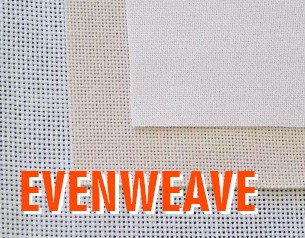
Evenweave fabrics are best for surface embroidery. It has the same number of warp and weft threads and the threads are also of the same size and thickness. This will form an even grid of the threads. Loosely woven fabric is ideal for counted thread techniques. It is also available in a wide range of colors and also in thread count.
Aida Cloth
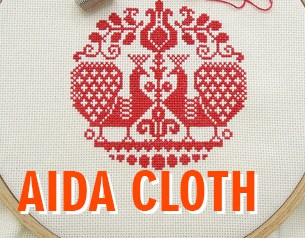
This is good for most beginner embroiderers. This is 100% cotton fabric and is woven with a group of fibers forming even squares in the fabric. It is popular with cross stitchers as its squares are easy to count and follow. It can also be used for surface embroidery, counted thread, and Assisi embroidery. The best part of Aida cloth is that you can see where your needle goes and thus you can count your stitches easily and follow the design.
Aida cloth is available in count range from 8 counts to 20 counts. Mostly it is available in 11 counts to 22 counts. Higher the count of Aida cloth smaller the work. Generally, Aida is stiff fabric but it also comes in soft too.
Linen
Linen is a great looking fabric with a gorgeous texture. It has an uneven surface because of the thin and thick threads in its weaving, but the beauty of fabric makes it bearable. There are different thread counts for linen. Due to its beauty and texture, it gives a classy look to your embroidery stitches. Linen blended with silk is also used for embroidery.
Silk

Silk is a beautiful fabric that is mostly used for making dresses and home decor. Embroidery on this fabric is a bit difficult. This fabric is tightly woven hence one needs to use the sharpest and thinnest needle with a very small eye as the blunt tip of the needle will be difficult to go through the fabric. Big needles or needle with a big eye can leave a visible hole in the fabric. Embroidering on silk dresses are practiced for centuries and it gives the most beautiful and gorgeous look to dresses.
Cotton Muslin
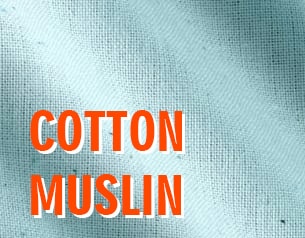
Cotton muslin is most commonly used fabric for embroidery. It is plain weaved fabric and it starts with a thread count of 70 to 250. More the count, finner the fabric would be. The fabric of 250 counts is tightly woven and it doesn’t damage when tightly fixed in the embroidery hoop.
It is more suited for freestyle embroidery as it is very fine and hence you can not see where to put a needle through the stitching.
Other Characteristics of hand embroidery fabric
There are other Characteristics that are also helpful while selecting fabric for embroidery.
Fiber Content
There are a variety of fabrics that are made from natural fibers like 100% cotton, linen, wool, silk, there are also occasionally blends made from these fabrics. Natural fibers are soft, yet are sturdy enough to support decorative stitching. The natural fibers allow a needle to easily pass through, as it runs both horizontally and vertically.
Some fabrics are synthetic and also synthetic blends. Your needle may prick threads, causing it to wear out over time.
Some prefer to use natural fibers and some use both natural and synthetic fibers.
Weave count
Weave count means the gap between warp and weft threads of fabric. For counted embroidery, cross-stitch, blackwork, etc. the fabric in which the spacing of warp and weft are less means there are visible gaps between each intersection points are commonly used. For surface embroidery, it is preferred to use dense fabric with narrow fibers in which the gaps are not easily visible and the cloth appears to be thick.
Texture of fabric
Even Texture of fabrics plays a good role in embroidery, for example, Linen is a commonly used fabric for embroidery but it has uneven fibers and thus gives uneven texture for embroidery. Also, a smooth texture with less bumpiness is widely used. Smooth texture gives an even feel to embroidery surface. As too many surface unevenness can restrict the embroidery stitches.
Weight
Again, fabric weight depends upon the final project and also which stitches you are planning on it. If you want delicate stitches it would be good to go with lightweight fabric. If you want heavy stitches or Crewel Work you can select medium or heavy fabric like cotton or linen.
Basically, select the fabric weight that will support the embroidery stitches you are planning to do on it.
Color
Yes, Color is important while selecting base fabric for your embroidery project. You know what color fabric you want for your embroidery project. If any point of time you are not sure about the base color of the fabric, you can go with off-white, pastel, or natural color, these color fabric generally goes with most shades. If you want to use dark color fabric, you can try light and bright color floss for embroidery.
The best beginner fabric for embroidery
If you are a beginner, try using fabric made from natural fibers like cotton, linen, etc. these fabrics easy for embroidery. Select off white color as a base and start with simple design. Once you know the stitches, you can proceed with advanced stitches and complex designs.
Beginner Friendly Tips
- If you are a beginner, try plain cotton muslin while starting.
- Pre-Wash the fabric to Avoid Puckering.
- Avoid using satin and other very smooth and shiny fabrics in beginning, of course, you can use them once you become comfortable with stitches and use of a needle.
- There are many types of embroidery floss available in the market, no doubt all are super attractive to use. As a beginner, you should start with 6-stranded cotton floss while you practice your skills.
- There are many basic embroidery stitch to get started, like running stitch, blanket stitch, back stitch, stem stitch, etc.



